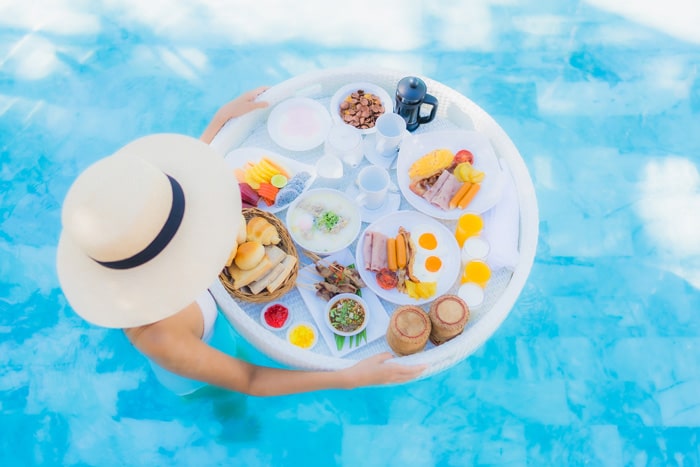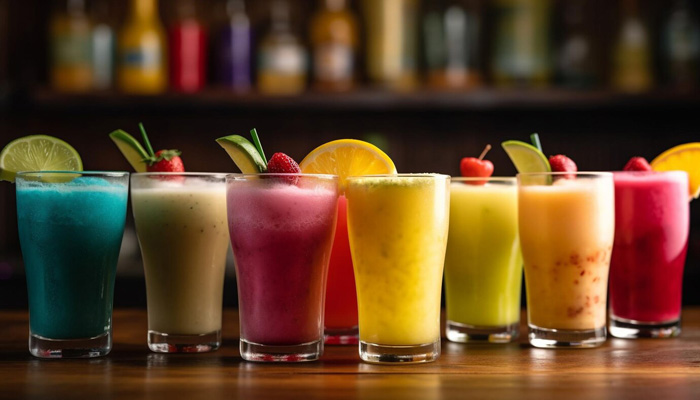Intro:
India is often called the “Land of Chai.”. People are extremely fond of various types of tea in India, and our Lord has bestowed this country with an incredible diversity of tea from the hilly region of the north to the sea surrounding the south, and from the serene slopes of Darjeeling to the leafy tea gardens of Assam, our country has a treasure collection of huge tea varieties.
In this article, we’ll discuss the varieties and types of tea in India according to their manufacturing process, grade & quality and will explore their origin, health benefits, price, and taste that define this nation.
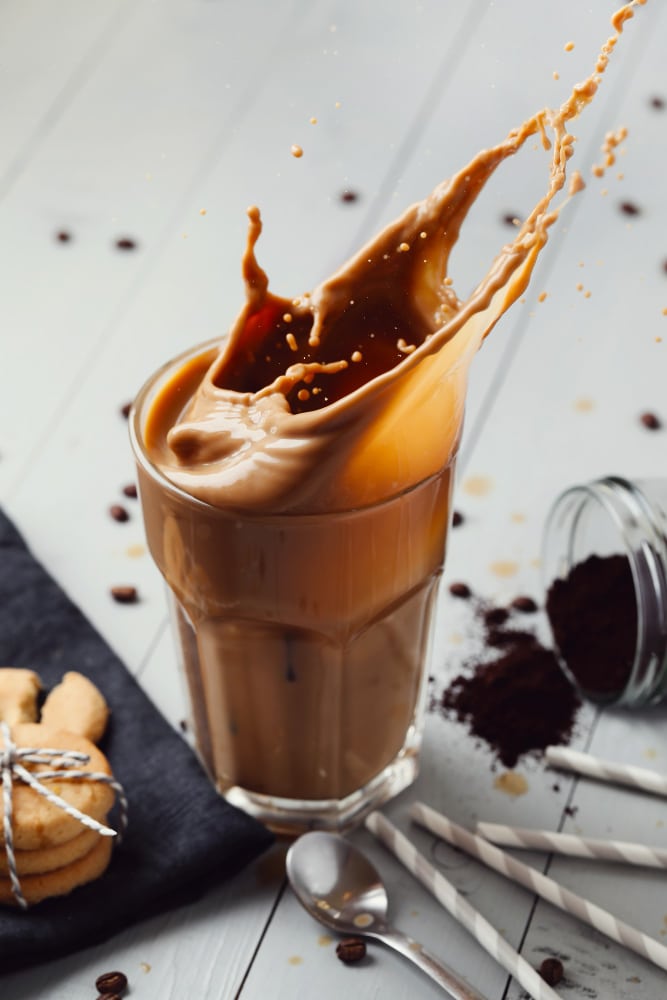

Know Your Tea First:
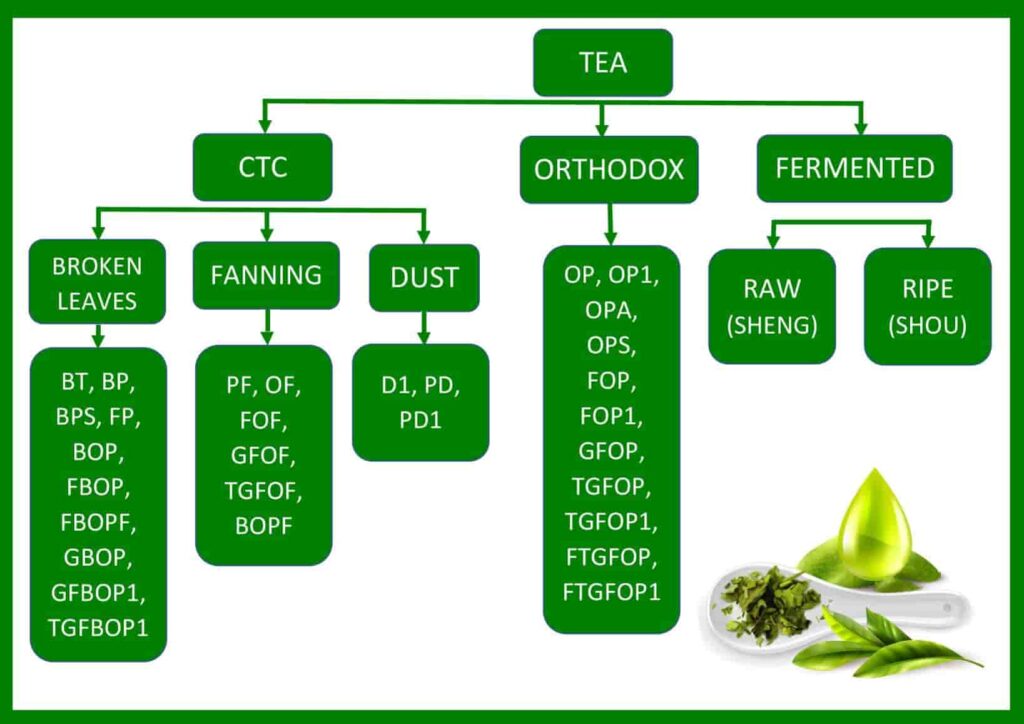
If you visit an exclusive tea showroom and ask for tea, then the first & foremost question from the salesperson will be, “Which tea will you prefer, sir? Black, White, Yellow, Green, Oolong, or Fermented/Puerh?”
You may be confused about choosing the right one if you don’t know all about tea in detail. Don’t worry, I will make it all clear.
Actually, we, the Indians, mostly use black tea. Black tea is again divided into CTC (Crash, Tear & Curl) tea and Orthodox tea. CTC tea is graded as Broken Leaf, Fanning, and Dust Grade. The other type of tea is fermented, or puerh tea, which is a unique type of tea that undergoes a specific fermentation process over a long period of time. This is also black tea, but sometimes made with green tea.
This fanning and dust grade is most commonly used by people in most countries. The tea bags served in trains by the vendor are mostly dust-grade tea, which is the least expensive. Fanning and sometimes BOP-Broken Orange Pekoe (a variety of broken leaf) are usually served on economy-class flights.
High-expensive Orthodox tea is served in the first class and business class by some flight companies.
CTC is crashed tea, which is less expensive, and Orthodox is whole-leaf tea, which is highly expensive. Fermented tea is made by the fermentation process. These are also very expensive.
Orthodox or whole-leaf tea grades from lower to higher are: OP, OP1, OPA, OPS, FOP, FOP1, GFOP, TGFOP, TGFOP1, FTGFOP, FTGFOP1, STGFOP, and SFTGFOP (Top Grade).
CTC tea grades are: broken leaf, fanning, and dust.
Broken leaf grades are: BT, BP, BPS, FP, BOP, FBOP, FBOPF, GBOP, GFBOP1, and TGFBOP1 (Top Grade).
Fanning: PF, OF, FOF, GFOF, TGFOF, and BOPF (Top Grade)
DUST-D1, PD, and PD1 (Top Grade).
This is the gist. Let’s learn more…
Market Value of Tea in India:
Approx. ₹10,000 crore is the estimated market size of tea in our country, India. Approx. 22 crore kg of tea is exported from India every year. India is the second-largest producer (just after China) and the fourth-largest exporter (following China, Kenya, and Sri Lanka) of tea in the world. In 2023, our country will generate $16.66 billion in revenue from tea exports.
The Indian government. has imposed certain obligations on exporting tea to meet our domestic requirements and be self-sufficient. Otherwise, India would have held the second position in terms of exporting, just after China. China is the biggest producer and exporter of tea.

Various Types of Tea in India
These teas can be categorized into 3 distinct groups based on their place of origin, species, and the unique processes used in their preparation.
Before that, we have to know that teas are basically of 3 types according to their manufacturing process. These are CTC (Crush, Tear, and Curl) Tea, Orthodox or Traditional Leaf Tea and Fermented or Pu-erh Tea.
1. CTC (Crush, Tear, and Curl) Tea:

Actually, CTC tea is a machine-processed and fully oxidized tea. CTC tea is less expensive and of lesser quality than Orthodox tea. CTC teas are a mixture of tea leaves harvested from more than one plantation. It is collected from the first “flush” or harvest, but if it is not found in adequate quantity, it is again collected from the second “flush.”.
Then it is processed by a machine with a series of cylindrical rollers that contain numerous sharp teeth that crush, tear, and curl the tea into small, hard pellets.
Basically, this tea deals with black tea only, and among lots of tea varieties, this one is the most demanded type of tea in India.
CTC teas are classified into 3 distinct categories: broken leaf, fanning, and dust, and all three have different grades according to their quality.
Broken Leaf Tea

Broken Leaf Grades, from lowest to highest, are:
- BT: Broken Tea. Mainly used in Sumatra, Sri Lanka and India.
- BP: Broken Pekoe. Mainly produced in Indonesia, Sri Lanka, Assam and India.
- BPS: Broken Pekoe Souchong. Mainly made in Assam & Darjeeling.
- FP: Flowery Pekoe. Kenya, Sri Lanka and India
- BOP: Broken Orange Pekoe. Found in Assam, Sri Lanka, India, Java, and China.
- FBOP: Flowery Broken Orange Pekoe. Assam, Sri Lanka, Indonesia, China, and Bangladesh.
- FBOPF: Flowery Broken Orange Pekoe Fannings. Produced in Sri Lanka.
- GBOP: Golden Broken Orange Pekoe. Second-grade FBOPF in . Sri Lanka.
- GFBOP1: Golden Flowery Broken Orange Pekoe 1. Best Quality of GBOP Grade.
- TGFBOP1: Tippy Golden Flowery Broken Orange Pekoe 1. The Finest is broken, and First Grade leaves Darjeeling and Assam.
Fanning Tea-

Fanning from lowest to highest grades are:
- PF: Pekoe Fannings.
- OF: Orange Fannings. From India and Africa, South America, and Nepal.
- FOF: Flowery Orange Fannings. Found in Assam, Dooars, Nepal and Bangladesh.
- GFOF: Golden Flowery Orange Fannings. This is the finest grade of Darjeeling tea. It is mainly used in tea bags.
- TGFOF: Tippy Golden Flowery Orange Fannings. Better quality of GFOF grade.
- BOPF: Broken Orange Pekoe Fannings. Main grade of Sri Lanka, Indonesia, Nepal, India, Kenya, Mozambique, Bangladesh, and China. Some other ingredients are added to this tea variety to make it unique and of the highest quality.
Dust Tea-
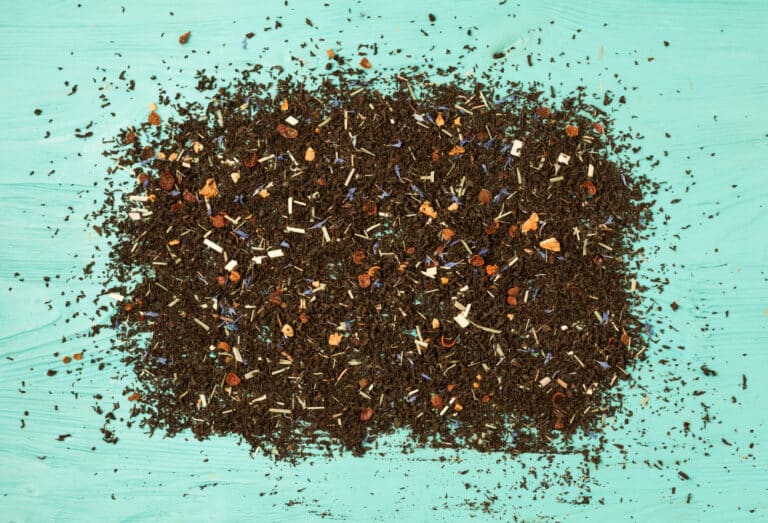
Dust from lowest to highest grades is:
- D1: Dust is indigenous to Sri Lanka, Indonesia, China, Africa, South America, India, and Bangladesh.
- PD: Pekoe Dust.
- PD1-Pekoe Dust 1. A better variety of PD is mainly produced in India.
2. Orthodox or Traditional Leaf Tea:

Orthodox tea is a traditional method of tea processing known for producing high-quality and full-flavored teas. It stands in contrast to the more modern and mechanized method of CTC (Crush, Tear, Curl) tea processing. Orthodox tea processing is particularly associated with the production of black tea, but it can also be used for green tea, oolong tea, and white tea.
These are very expensive and specially chosen for exporting outside our country. These exquisite-quality teas are auctioned at high prices and then especially packed for the royal families, kings, and rulers of countries. These are the symbols of pride and aristocracy. Also our vintage, heritage, and ecstasy as well.
These are the most prized teas among lots of types in India.
Characteristics of Orthodox tea:
3. Fermented or Pu-erh Tea-

Fermented tea, often referred to as Pu-erh tea (also spelled Puer or Pu’er), is a unique type of tea that undergoes a specific fermentation process. Pu-erh tea originates from the Yunnan province of China and has a long history dating back thousands of years. It is renowned for its distinct flavor, potential health benefits, and the way it changes over time, much like fine wine.
Pu-erh tea is made from the leaves of the Camellia sinensis tea plant, just like green, black, and oolong teas. However, what sets it apart is the fermentation process. After the leaves are harvested and withered, they undergo microbial fermentation, which can be either natural or controlled. This fermentation can last for weeks, months, or even years, depending on the desired outcome.
There are two main types of Pu-erh tea: raw (sheng) and ripe (shou or shu).
Raw pu-erh: This type is fermented naturally and undergoes aging over time. It typically has a more robust and earthy flavor when it’s young and becomes smoother, mellower, and more complex as it ages. Raw pu-erh is often compared to fine wine and can be aged for decades.
Ripe Pu-erh: Ripe Pu-erh undergoes an accelerated fermentation process, resulting in a tea with a dark, rich color and a deep, earthy flavor. This type of pu-erh is preferred by people who want immediate and consistent taste, as it doesn’t require extensive aging.
Tea by Place:
India has unity in diversity in many aspects. People, religion, customs, language, and the characteristics of the land. Different types of land yield different types of fruits and crops. Tea is mainly produced in places with hilly and sloppy land areas and huge rainfall.
Here we will discuss the teas that originated from specific places and are famous for their tea production. The name of the tea also goes with the name of the places. Such as Darjeeling Tea, Assam Tea, and so on.
1. Darjeeling Tea:

Nestled in the Himalayan foothills of West Bengal, Darjeeling is renowned for producing some of the world’s finest and most sought-after teas. Known as the “Champagne of Teas,” Darjeeling teas are famous for their beautiful fragrance and lovely flavor.
Darjeeling teas are harvested twice a year. The first flush is harvested in the early spring. It is characterized by its light and floral notes. The second flush is plucked in the late spring with a strong and rich flavor.
Darjeeling tea is typically processed as black, green, white, or oolong tea, catering to a wide range of preferences.
Darjeeling and Kalimpong districts of West Bengal were awarded the Geographical Indication Tag (GI Tag) in 2004. Darjeeling Tea is no doubt the finest tea in our country and the most sought-after tea in the world.
Silver Tips Imperial Tea of Darjeeling is sold for around $2000, or ₹1.65 lakh per kg. It is the most expensive tea in India.
2. Assam Tea

Assam is one of the seven sister states in northeastern India and is the birthplace of world-famous black tea. The region’s fertile plains and ideal climate make it perfect for growing the “Camellia sinensis var. assamica” tea plant. Assam tea is known for its briskness, as it dilutes very quickly in water or milk and for its amazing flavor, which makes it an excellent choice for breakfast teas around our country, India and the world as a whole.
It is often enjoyed with milk and sugar. Assam also produces specialty teas like CTC (Crush, Tear, Curl) and traditional regular Orthodox teas to bring diversity in tastes.
Golden Pearl Tea is a very expensive variety of tea from Dibrugarh, Assam and it costs ₹1.51 lakh per kg.
Manohari Gold is one of the rare Assam tea varieties and is sold at ₹1,00,000 per kg.
3. Nilgiri Tea:

The southern state of Tamil Nadu is home to several tea-growing regions, including the Nilgiri Hills. Nilgiri teas from Tamil Nadu are known for their bright and brisk character, making them a vital component of the South Indian tea culture.
The Nilgiri Hills in southern India are home to a distinct tea culture. Nilgiri teas are also known as “Blue Mountains” teas and are appreciated for their bright, brisk character and floral feelings. These teas are usually crafted as black teas but are also used in blends as a base for flavored teas.
Nilgiri Frost Winter Tea is the most expensive variety of Nilgiri Tea, worth ₹30,000 per kg.
4. Kangra Valley Tea-

The Kangra Valley is situated in Himachal Pradesh and is a lesser-known tea-producing region in India. Kangra teas are light, aromatic, and possess a unique, vibrant quality. They are often crafted as green teas and are appreciated for their freshness and passionate color.
Kangra Valley Tea is a symbol of naturalness, purity, love, and sustainability. Kangra tea is priced between ₹17,000 and ₹20,000 per kg. The biggest company in this region is DHARMSALA TEA COMPANY, and their famous brand, HIBISCUS DETOX BLEND, is one of the most prized teas in our country.
5. Sikkim Tea-

The picturesque state of Sikkim, nestled in the Himalayas, is gaining recognition for its high-quality tea production. Sikkim teas are known for their floral note and incredible aroma. It is often compared to Darjeeling teas. The region’s unique soil greatly contributes to the special characteristics of tea production.
Temi Sikkim Tea is a highly exclusive and much-demanded tea in India from the Temi Tea Estate Company, the only tea company in Sikkim. This tea is sometimes considered a more premium tea than the Darjeeling Tea, arguably. It is one of the most prized and rarest types of tea in India. Sikkim tea is mainly white and oolong tea.
The price of Temi Sikkim tea ranges from ₹17000 to ₹18000 per kg.
6. Munnar Tea-

Munnar is located in the Western Ghats of Kerala and is known for its scenic tea gardens and the production of exquisite teas. Munnar teas are characterized by their bright infusion and brisk flavor. It is also a notable tea among the many types of tea in India.
The finest Munnar Surianalle tea price is ₹1000/kg.
7. Nepal Tea-
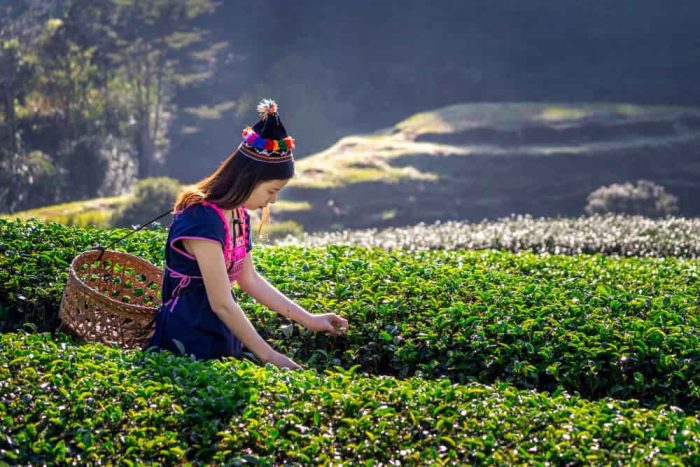
Though not part of India, Nepal, situated in close proximity to Darjeeling and Sikkim, produces teas that share some similarities with their Indian counterparts. Nepali teas are grown at high altitudes and deliver a unique flavor that combines the qualities of Darjeeling and Chinese teas. They are easily available in India.
Himalayan Spring White Tea, Nepalese Gold Black Tea, and Amber Autumn Oolong Tea are the top three varieties popular in Nepal and around the world.
The price of Nepalese gold black tea is ₹40000 per kg.
Tea by Variety-
1. Black Tea-
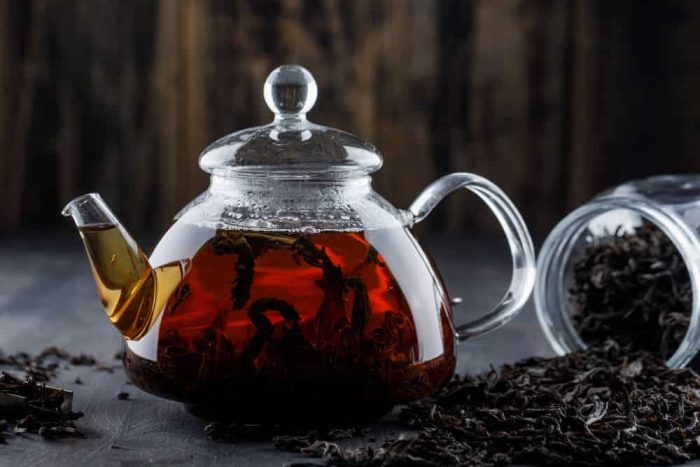
Black tea is the most popular type of tea in India and is the foundation for classic Indian chai. These teas are oxidized but retain their original flavor and health benefits as well. Assam, Darjeeling, and Nilgiri teas all contribute to India’s diverse black tea varieties and combinations.
2. Green Tea-
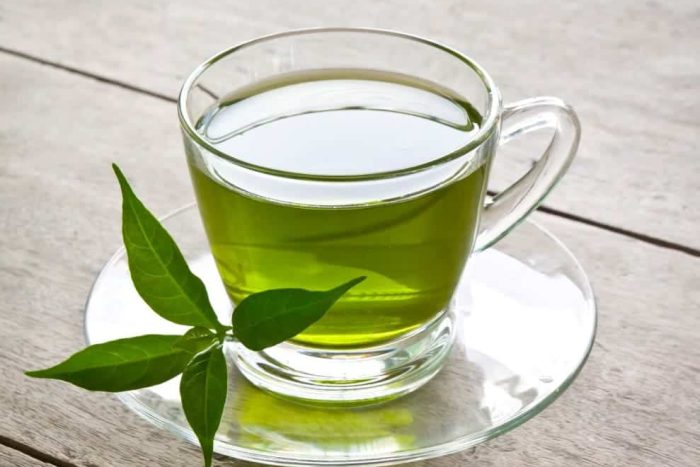
Green tea is consumed for its health benefits and delicate flavor. In India, regions like Darjeeling and Kangra produce exceptional green teas. These teas are unoxidized and retain their natural green color and grassy, vegetal notes.
3. White Tea-


India also produces exquisite white teas, known for their minimal processing and delicate taste. Darjeeling, in particular, offers exceptional white teas with subtle, floral characteristics.
4. Oolong Tea:
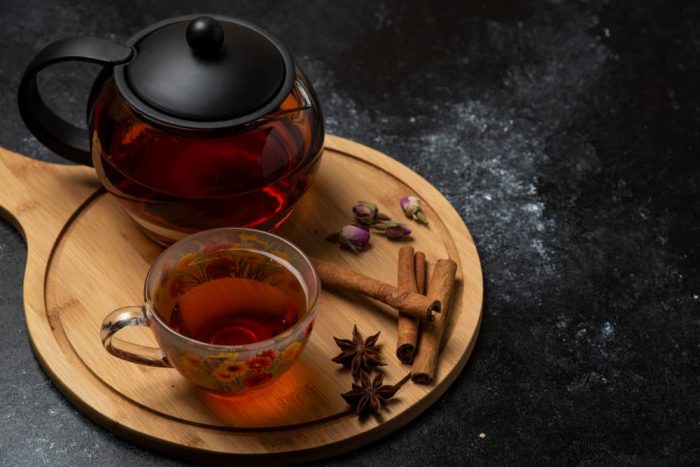
Oolong tea is less common in India compared to black and green teas. Oolong teas are crafted with high care in places like Darjeeling, Assam and the southern part of India. These teas are semi-oxidized and deliver a unique balance between black and green teas.
4. Yellow Tea
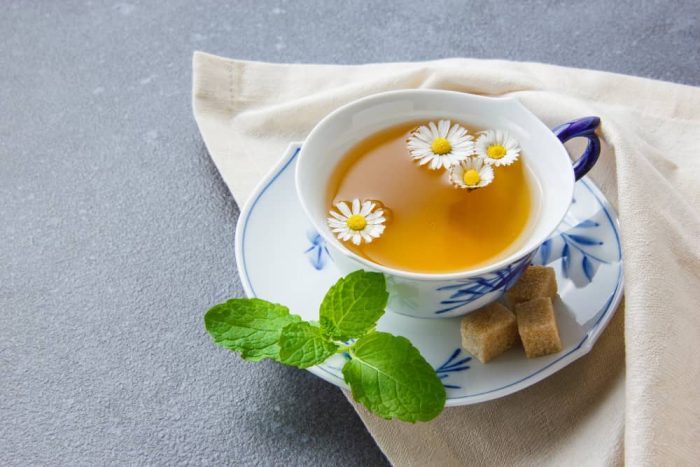
Yellow tea is a rare variety of tea. It is specially cultivated and is found in some Indian tea gardens. It is known for its mellow flavor and slightly sweet, floral fragrance.
Tea By Process:
1. Masala Chai-

No discussion of Indian tea would be complete without mentioning Masala Chai. This spiced tea is made by brewing black tea leaves with aromatic spices like cardamom, cinnamon, ginger, and cloves, along with milk and sugar. It’s a relaxing and refreshing beverage and an integral part of Indian culture.
2. Tandoori Chai-
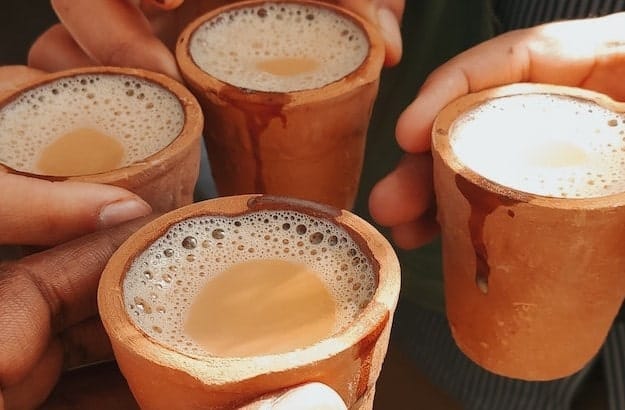
A recent innovation in the world of tea, Tandoori Chai adds a smoky twist to the classic beverage. Tea is brewed in a clay tandoor oven, infusing it with a unique smoky flavor. It’s gaining popularity in India and around the world as well.
3. Kahwa Tea-

Kahwa is a traditional tea in the Kashmiri region. It combines green tea leaves with saffron, cardamom, and almonds, which creates an aromatic and relaxing beverage.
4. Herbal Tea-

Herbal infusions, or herbal teas, are also very popular among Indians. It is combined with Tulsi (Holy Basil), which is believed to have various health benefits and has great religious prospects. Sometimes it is blended with peppermint, ginger, lemongrass, lavender, sage, licorice, hibiscus, or German chamomile. These infusions are caffeine-free and offer a wide range of flavors and health benefits.
Tea by Brand
1. Tata Tea
- Established: 1964.
- Parent Company: Tata Global Beverages.
- Origin: Travancore, Kerala.
- Annual turn-over: 9300 Cr.
- Yearly sale volume: 7 crore kg.
- Amazon rating: 4.5
2. Wagh Bakri Tea
- Established: 1862.
- Parent Company: Gujarat Tea Processors and Packers Limited (GTPPL)
- Origin: Gujrat, Ahmedabad.
- Annual turn-over: 2000 Cr.
- Yearly sale volume: 5 crore kg.
- Amazon rating: 4.4
3. Brooke Bond Tea
- Established: 1869.
- Parent Company: Lipton Teas and Infusions. (Hindustan Unilever acquired Brooke Bond globally in 1984)
- Origin: Manchester, England. (Now Andheri, Mumbai, Maharashtra)
- Annual turn-over: 38,000 crore. (Globally)
- Yearly sale volume: N/A.
- Amazon rating: 4.4
Conclusion:
In conclusion, all types of tea in India represent unique tastes and flavors. Each variety reflects its special and distinctive nature, which represents the traditions and culture of its origin.
In the glorious hills of Darjeeling, in the fertile plains of Assam, and in the peaceful Nilgiri Hills, India’s diverse tea landscape offers a vast variety of delicious tea that has been loved not only by the Indians but by the entire world.
Whether you prefer the robustness of Assam black tea, the elegance of Darjeeling oolong, or the comforting embrace of Masala Chai, India’s tea offerings are as diverse as the country itself. Different types of tea in India invite people to embark on a delightful journey of tea exploration.
FAQ:
Tea is a significant source of antioxidants like Catechins and Theaflavins. These elements combat oxidative stress and play a pivotal role in preventing cancer and heart disease. Tea can reduce different health issues depending on how it is prepared. Tea may also cure diabetes. It also contains Calcium for better bone health.
Green tea is best for overall health according to much research and experience.
In the 12th Century, Tea was first consumed by the Singpho tribe of Assam in India. In the 16th century, tea was taken as a medicine for healing stress, anxiety, headache, etc. by the people of western India. Later in 1850, the British introduced tea cultivation in Darjeeling and the Hilly region of the Himalayas to break the monopoly of China.
Tata Tea, capturing 30% of the market share in India. The company started its journey in 24th October 2008. In 2023 the company’s annual revenue generation is $1.7 Billion, i.e. approx ₹1400 crore.
Charles Alexander Bruce, a British Colonial first planted tea plant in Assam, is called the father of tea in India.
Assam Tea Company India Pvt. ltd.
Maniram Dutta Baruah (1839-1841). Later, the British hanged him for participating in Mutiny against the British.




